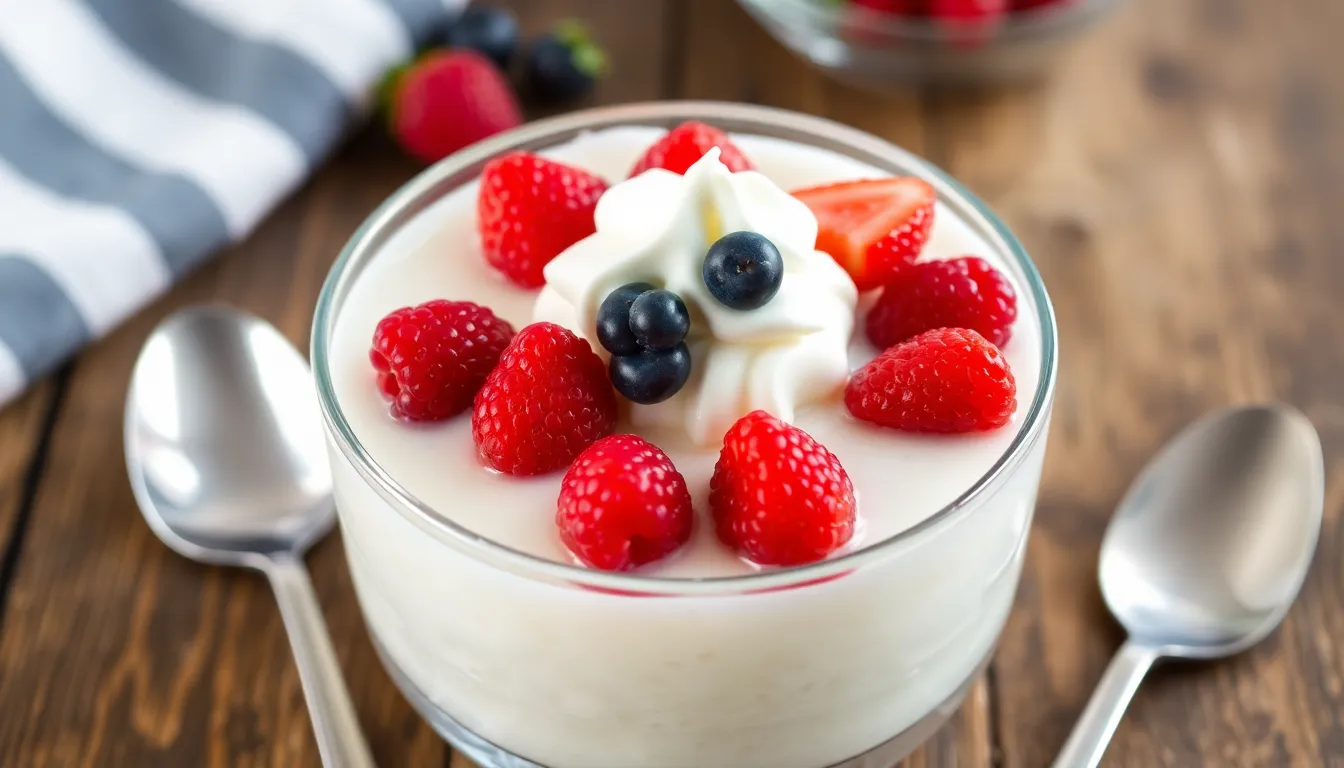Tapioca might just be the underdog of the culinary world, but this humble starch packs a punch. Known for its delightful chewy texture, it’s time to give tapioca the spotlight it deserves. From creamy puddings to savory dishes, this versatile ingredient can transform any meal into a culinary adventure.
Imagine sinking your teeth into a warm tapioca pudding that feels like a hug in a bowl or savoring crispy tapioca chips that could rival any potato snack. With a sprinkle of creativity, the possibilities are endless. So grab your apron and get ready to whip up some delicious tapioca recipes that’ll have everyone asking for seconds. Who knew a little starch could lead to such a tasty escapade?
Tapioca Recipes
Tapioca is a starchy substance extracted from cassava root. This versatile ingredient offers unique texture and can be utilized in various culinary applications.
Origin of Tapioca
Tapioca originates from the cassava plant, native to South America. The indigenous peoples of Brazil have long used this root for food. As tapioca became popular, it spread to Africa and Asia, where it gained culinary significance. Its production process involves peeling, soaking, and grinding the cassava into pulp. After extraction, the pulp undergoes rinsing and drying, resulting in the familiar tapioca pearls, flakes, or flour.
Nutritional Profile
Tapioca is primarily composed of carbohydrates, providing a significant energy source. One serving of cooked tapioca contains approximately 100 calories, with minimal fat and protein. Rich in starch, tapioca lacks fiber and essential nutrients. However, it is gluten-free, making it suitable for those with gluten intolerances. Additionally, tapioca serves as a source of easily digestible energy, making it helpful for individuals with sensitivity in their digestive systems.
Popular Tapioca Recipes

Tapioca’s versatility shines through various recipes that highlight its unique texture and taste. Here are some favorites.
Classic Tapioca Pudding
Classic tapioca pudding combines tapioca pearls, milk, sugar, and vanilla. This dish features a creamy base, resulting in a rich dessert that’s both comforting and satisfying. Preparation involves simmering the tapioca in milk until it thickens, followed by stirring in sugar and vanilla extract. Some people enjoy serving it warm, while others prefer it chilled. Toppings like fresh fruit or whipped cream enhance its appeal and flavor.
Tapioca Pearls in Bubble Tea
Tapioca pearls play a crucial role in bubble tea, a popular drink enjoyed worldwide. Customers savor the chewy texture of the pearls against the backdrop of sweetened tea or milk. Making bubble tea requires cooking the tapioca pearls until they are soft and translucent, usually taking about 30 minutes. Afterward, blending them with flavored tea and milk creates a delightful beverage. Variations abound, allowing for endless combinations of flavors and sweetness levels.
Savory Tapioca Dishes
Savory tapioca dishes showcase the ingredient’s culinary adaptability. Tapioca flour serves as an excellent base for dishes like Brazilian cheese bread, known as pão de queijo. This dish combines tapioca flour, cheese, and eggs for a chewy texture. Adding seasonings or herbs can elevate the flavor further. Additionally, tapioca can be used to create crispy snacks, such as tapioca chips, which make for a great appetizer or side. These dishes highlight the unique properties of tapioca in savory contexts.
Creative Uses for Tapioca
Tapioca offers numerous creative applications in the kitchen, showcasing its versatility beyond classic recipes.
Gluten-Free Baking
Baking without gluten becomes simpler with tapioca flour. This flour serves as an excellent substitute for regular flour in cookies and cakes. It adds chewiness and moisture, which enhances the texture of baked goods. Many gluten-free recipes incorporate tapioca to provide structure and elasticity, yielding delicious results. Almond flour or coconut flour often pair well with tapioca, creating flavorful combinations. These alternatives allow individuals with gluten intolerance to enjoy treats previously off-limits.
Thickening Soups and Sauces
Thickening soups and sauces efficiently occurs with tapioca starch. When mixed with cold water and heated, it creates a smooth, glossy texture in various dishes. This starch performs well in gravies, providing a shine without altering the flavor significantly. Those looking for alternatives to cornstarch or flour often find tapioca starch ideal due to its neutral taste. A subtle amount can enhance the consistency of sauces without overpowering their inherent flavors, making it a useful ingredient for chefs and home cooks alike.
Healthier Snack Alternatives
Tapioca contributes to healthier snack alternatives. It appears in the form of crispy, baked tapioca chips, offering a light and satisfying crunch. These snacks contain fewer calories than traditional potato chips, appealing to health-conscious individuals. Tapioca pops are another innovative snack, light and airy, they provide an alternative that satisfies crunch cravings without excess fat. Many incorporate herbs and spices for added flavor, ensuring these snacks are not only healthy but also delicious. Enjoying tapioca in snack form presents an exciting way to include this versatile ingredient in daily diets.
Tips for Cooking with Tapioca
Cooking with tapioca opens up a world of culinary possibilities. Understanding its characteristics helps create delicious dishes.
Choosing the Right Type
Selecting the appropriate tapioca form is essential for success in cooking. Tapioca pearls, available in various sizes, work best for puddings and bubble tea. For baking, tapioca flour offers a gluten-free alternative, adding moisture to many recipes. Flakes can serve as a quick thickening agent in soups or sauces. Knowing the right type enhances the final dish’s texture and flavor.
Cooking Techniques
Utilizing correct cooking techniques maximizes tapioca’s potential. Soaking tapioca pearls in water before cooking softens them, resulting in a chewier consistency. Boiling in milk or water remains a common method for preparing puddings. Gradually adding tapioca flour to liquid while stirring prevents lumps when thickening sauces. Baking delicacies like Brazilian cheese bread requires specific temperature control to achieve that perfect chewiness. Employing these techniques ensures a satisfying culinary experience.
Conclusion
Tapioca’s culinary potential is vast and exciting. Whether it’s transforming traditional desserts or creating innovative savory dishes, this versatile ingredient can elevate meals in countless ways. Embracing tapioca opens up a world of flavor and texture that many might not have explored yet.
With its gluten-free nature and adaptability, tapioca is a fantastic choice for various diets. From creamy puddings to crunchy snacks, the possibilities are endless. Experimenting with tapioca not only adds variety to the kitchen but also invites creativity and fun into everyday cooking. So why not give it a try? Discover the delightful dishes tapioca can bring to the table.

